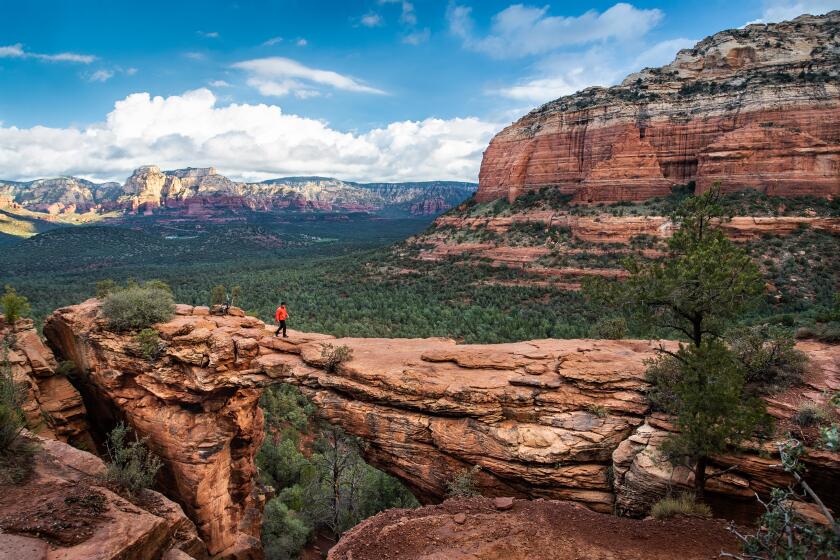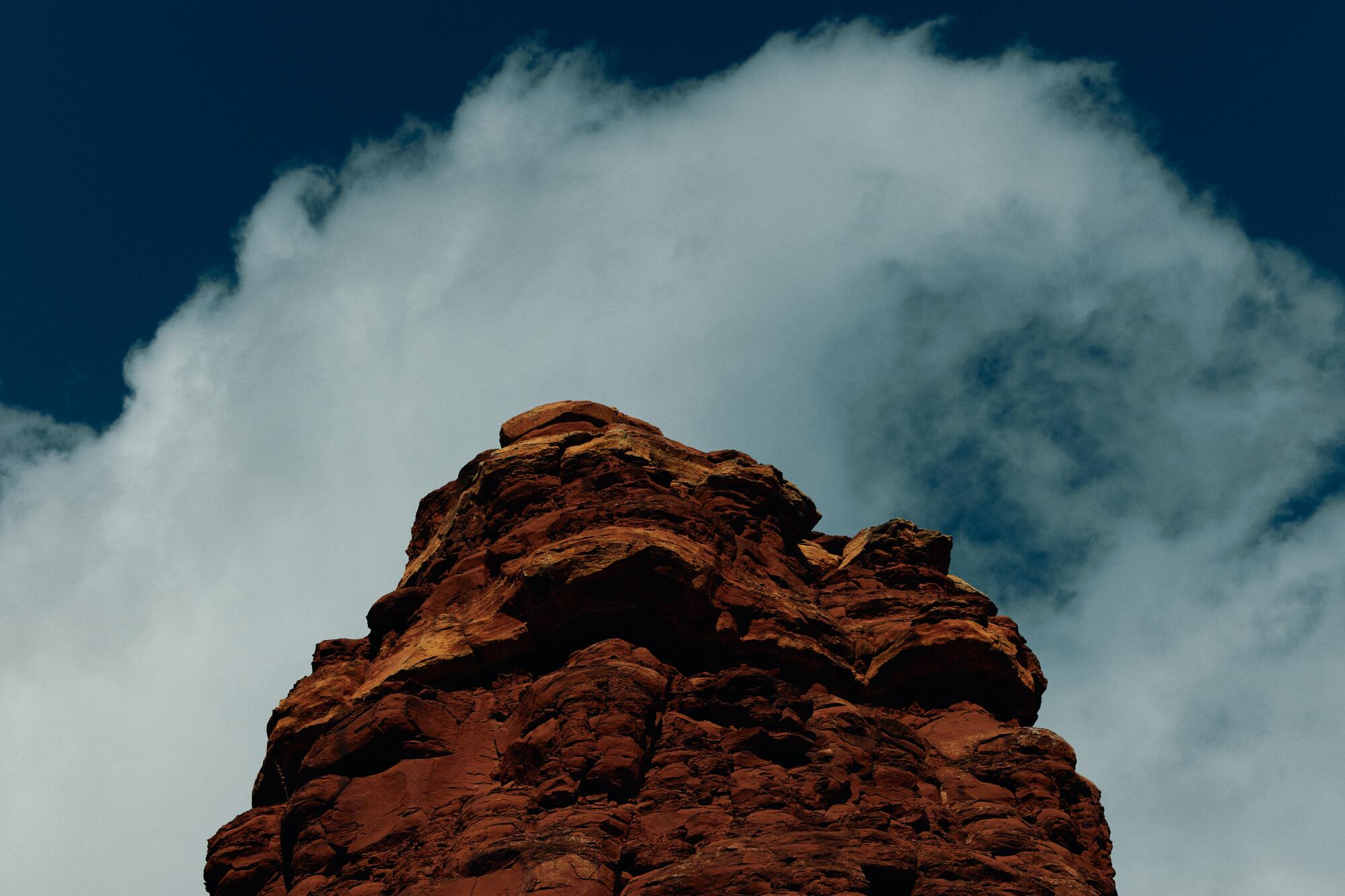
Sedona’s energy vortexes beckon droves of spiritual seekers. But what is a vortex really — and is Sedona the only place to feel one?
- Share via
SEDONA, Ariz. — The rock formation known as Kachina Woman rises like an obelisk out of a cool green canyon. At its base, more than three dozen women are tucked into crevices in the rust-colored stone, their faces turned toward the warm Arizona sun. Some sit with their legs crossed. Others are curled into a fetal position. They did not all come together, but they came for the same purpose: to soak up the energy of one of the most popular vortexes in Sedona.
Surrounded by towering mesas and spectacular vistas, and located on the ancestral home of the Yavapai people, the small town of Sedona has long been a destination for New Age seekers and the astrologers, psychics, tarot readers, shamans and healers who cater to them. For the last 40 years, these spiritual pilgrims have been drawn to the region by tales of its mysterious and amorphous energy vortexes. Definitions vary, but Sedona’s vortexes are generally understood to be geographical sites of invisible and potent spiritual energy, usually associated with specific rock formations.

A tree stands starkly at Boynton Pass, a popular site for vortex tourists, in Sedona. (Adam Riding / For The Times)

Red rock at Boynton Pass. This image was shot on location through a circular glass dish. (Adam Riding / For The Times)

Books on the vortexes — what they are, where to find them and the unique energies you might experience at each one — line the shelves of the town’s many crystal shops and metaphysical bookstores. Visitors can choose from an array of vortex tours that might include a jeep ride, sound healing, guided meditation, yoga or all of the above.
Day trippers from California, traffic jams and lack of housing for workers are fueling local fights over tourism and marketing.
But as spiritual tourism in Sedona continues to grow, the region’s most famous vortexes have become increasingly popular and crowded. Now, as traffic clogs the town’s thruways and trailside parking becomes nearly impossible to find, some longtime vortex guides say a new understanding of Sedona’s vortex energy — and how to tap into it — is needed.
“It feels good when someone can point to a spot and say, ‘This is it,’” said Dennis Andres, a.k.a. Mr. Sedona, and the author of “What Is a Vortex?” and the soon-to-be-released “Experience the Vortex.” “But it’s not a spot. The energy is everywhere in Sedona.”
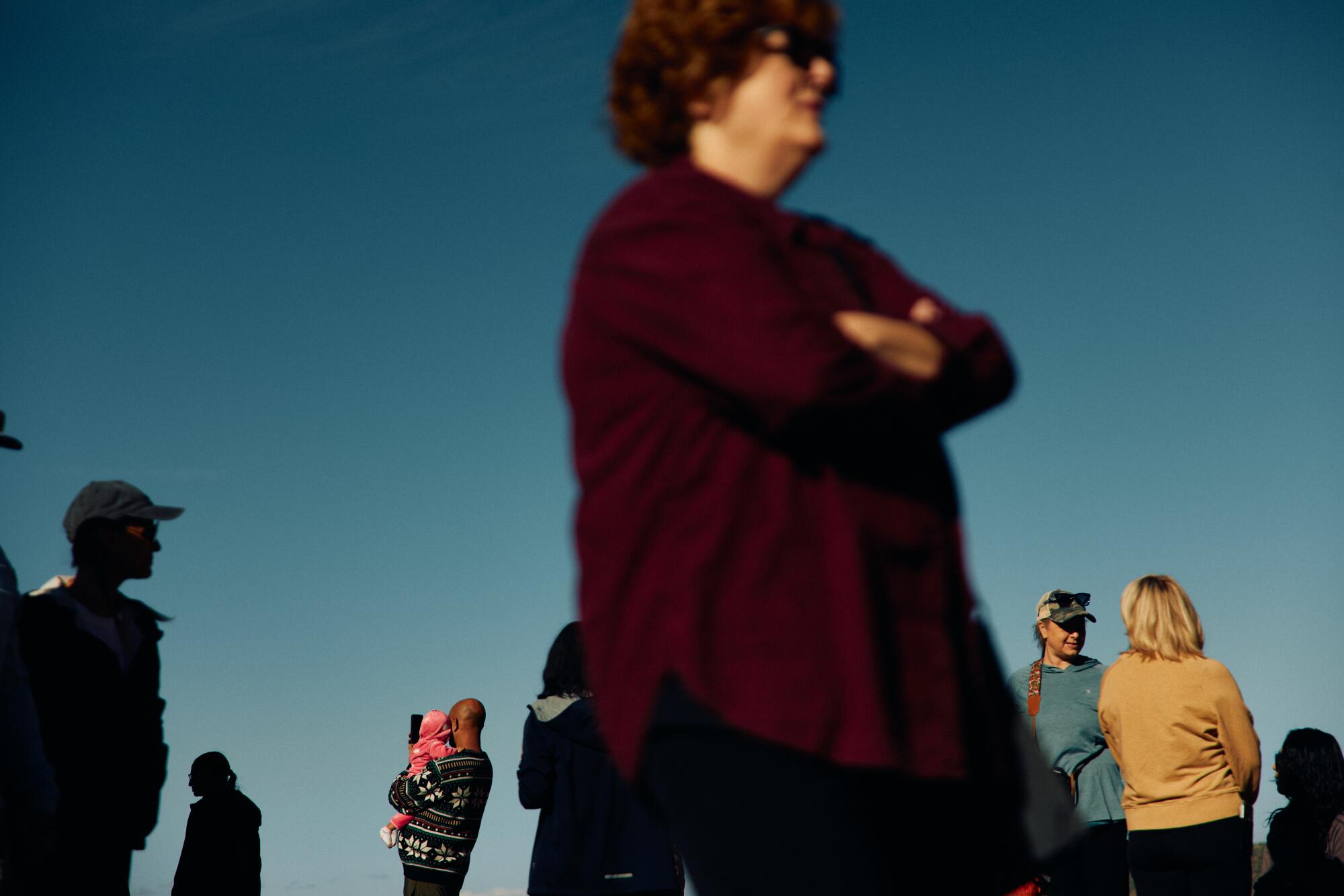
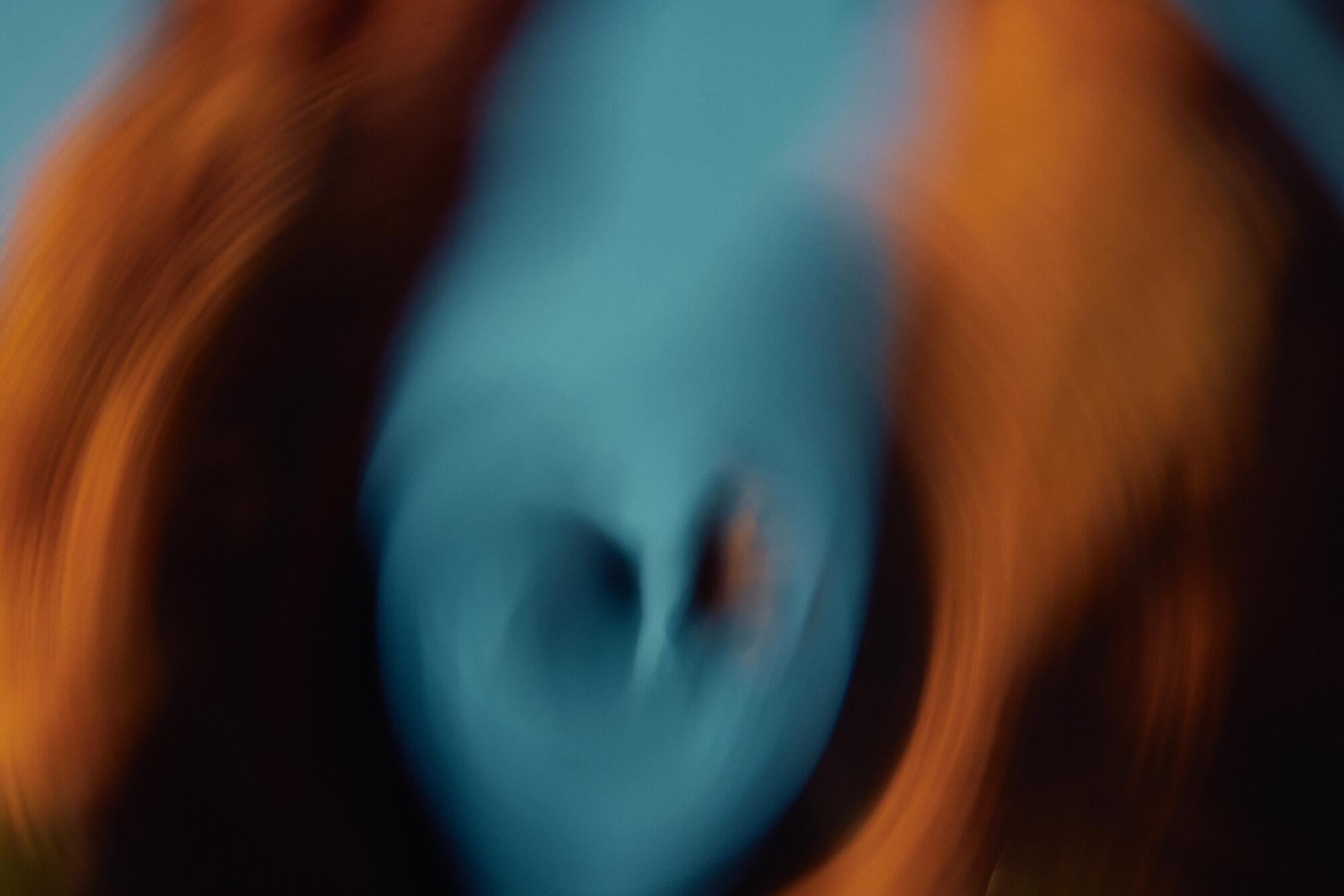
Big vortex energy
Historians trace Sedona’s New Age roots to the late 1950s when a handful of local women interested in metaphysics began hosting meditations in their homes, but the spiritual history of the land extends much further back in time. This red rock country, where massive rock formations rise like monuments from the landscape, is sacred to the Yavapai people, who were forced to leave in 1875, and who don’t believe in vortexes.
“I call it a tourist trap because it’s really overcrowded,” said Gertrude Smith, Yavapai culture director for the Yavapai-Apache Nation. “But for us, it’s a very important part of our people, and our history. A lot of our creation stories come out of that area.”
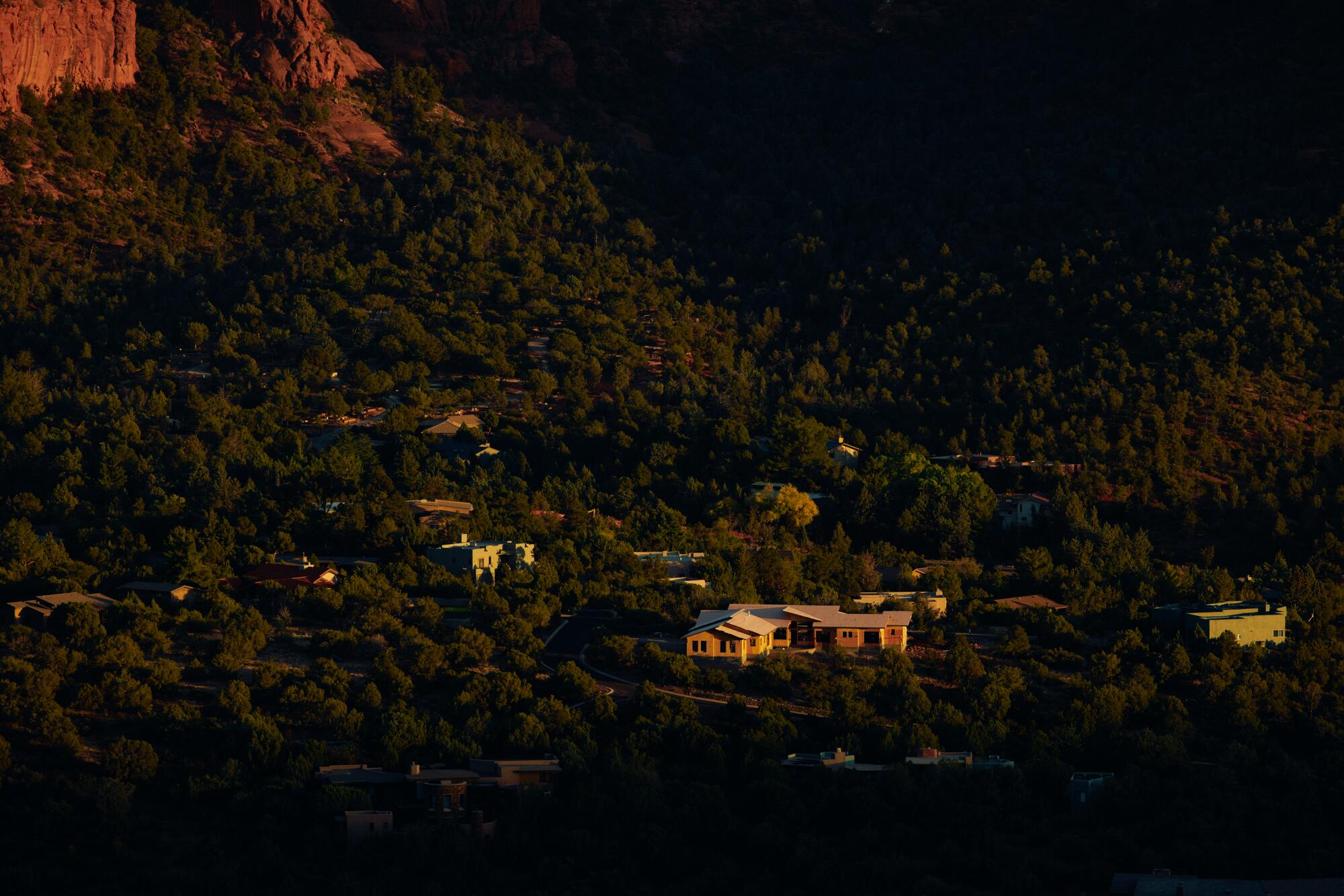
Each February, members of the nation hold a gathering in the Sedona area to pay tribute to what they call “the Great Exodus,” when the band was forced to trek 240 miles southwest across rugged terrain to another reservation. Many elders and babies died on the journey. Before the ceremony, members of the community go up to the site to clear the land of the medicine wheels, crystals and other talismans that are inevitably left by New Age seekers.
“I know for them that’s their belief, that they want to believe in something,” Smith said. “But these are our sacred sites and it makes our medicine man upset.”
Red Rocks Country has long beckoned weekend travelers from L.A. But many locals believe tourists are loving their town to death.
Yavapai religious practices have little to do with the four, seven or nine vortex locations (depending on what map you consult) that spiritual tourists seek today. These sites, which are all conveniently accessible via short trails near parking lots, were named in 1980 by psychic channeler Page Bryant and popularized by California psychic and self-help guru Dick Sutphen. The most famous are Airport Mesa (great for sunsets), Bell Rock (shaped like a bell), Cathedral Rock (which glows when the sun hits it) and Boynton Canyon (home to caves and ancient dwellings).
When Bryant identified the vortex locations, she also labeled each one as electric, magnetic or electromagnetic. The names were meant to be symbolic. Electric vortexes are believed to give off a stimulating and uplifting energy, while magnetic vortexes are said to offer a more receptive, focused and grounding energy. Electromagnetic vortexes are a combination of both. However, individuals’ experiences of the vortexes are often more varied than that.
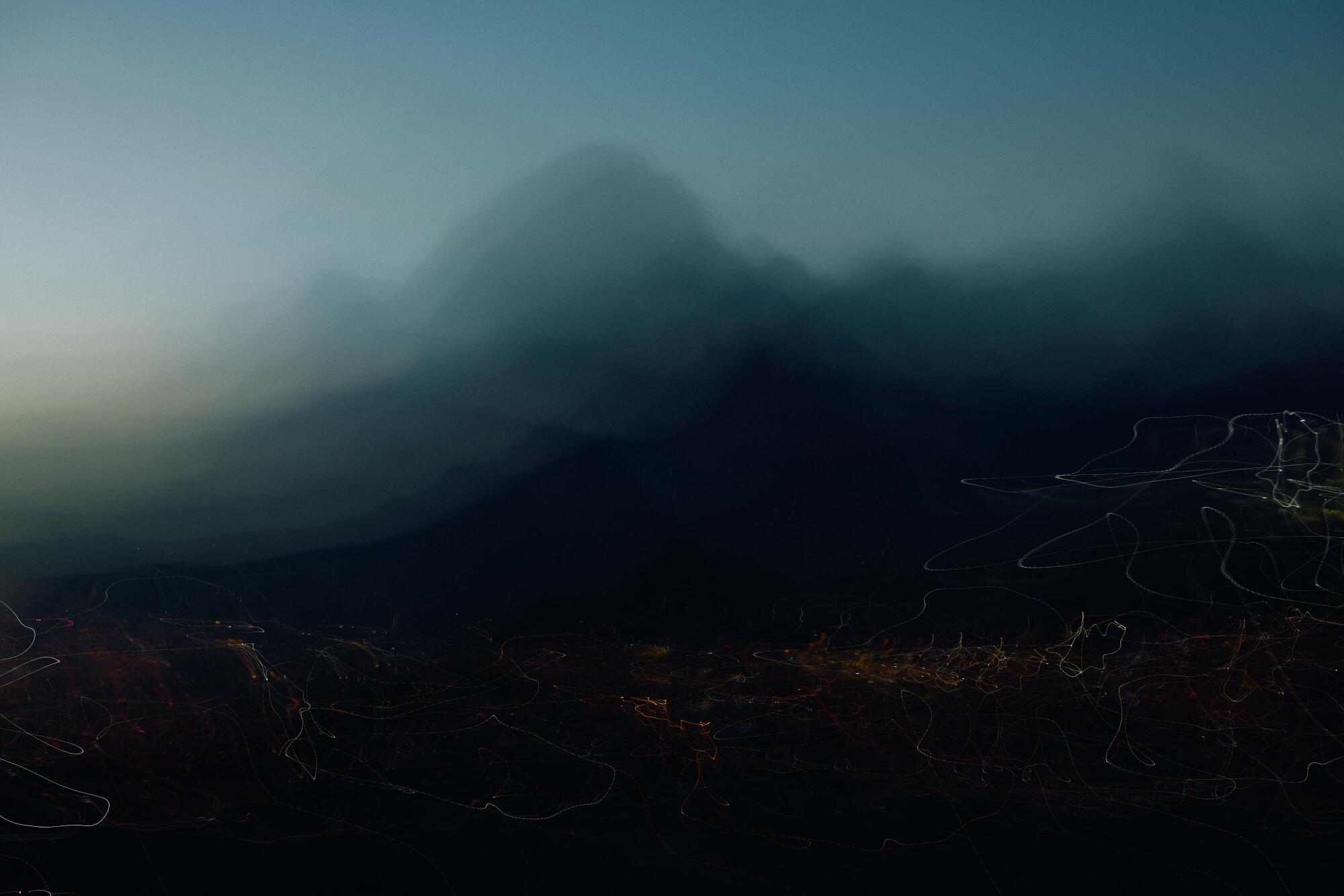

Cathedral Rock, a popular site for vortex seekers, is known to glow when the sun hits it. (Adam Riding / For The Times)

Pillars at Cathedral Rock catch the day’s first light. (Adam Riding / For The Times)
Gail Brown, a grandmother from Long Island who was among the women meditating at Kachina Woman in Boynton Canyon (electromagnetic vortex), said she felt peaceful and grounded during her time there, as if a calming energy was emanating from the Earth. Her sister Lynn Debaw, a retired gym teacher celebrating her 80th birthday, described it as a more spiritual feeling of opening and awakening in her heart.
LeeAnn Rigau, a retired teacher from Virginia, said that for her, the ground around the Bell Rock vortex (electric) felt spiked with a powerful current. “I was lying on bare rock, but when I put my arms down it felt like I was lying on six inches of grass because of the energy shooting up around my arms,” she said.
At the Courthouse vortex (magnetic), Anjuli Mahendra, who teaches yoga and massage in the Bay Area, said the energy felt earthy, downward and slow. “I felt like I was in a womb,” she said.
Southern California is filled with gorgeous Buddhist temples, meditation gardens, churches and synagogues that inspire awe. Here are some worth a visit. Get ready to be wowed.
And then there are people who don’t feel anything at all.
“This isn’t going to work for me,” said a woman from Maryland who declined to give her name, watching incredulously as a retreat group engaged in spontaneous movement and dance to process the messages they had received from the vortex at Boynton Canyon. “I guess you have to be a believer.”
But even as she joked with her husband about “scrambling the energies” by taking a selfie, she also marveled at the majesty of the landscape around her — the red rocks carved by the elements over millions of years, the bright green of the forest below, the expansive blue sky.
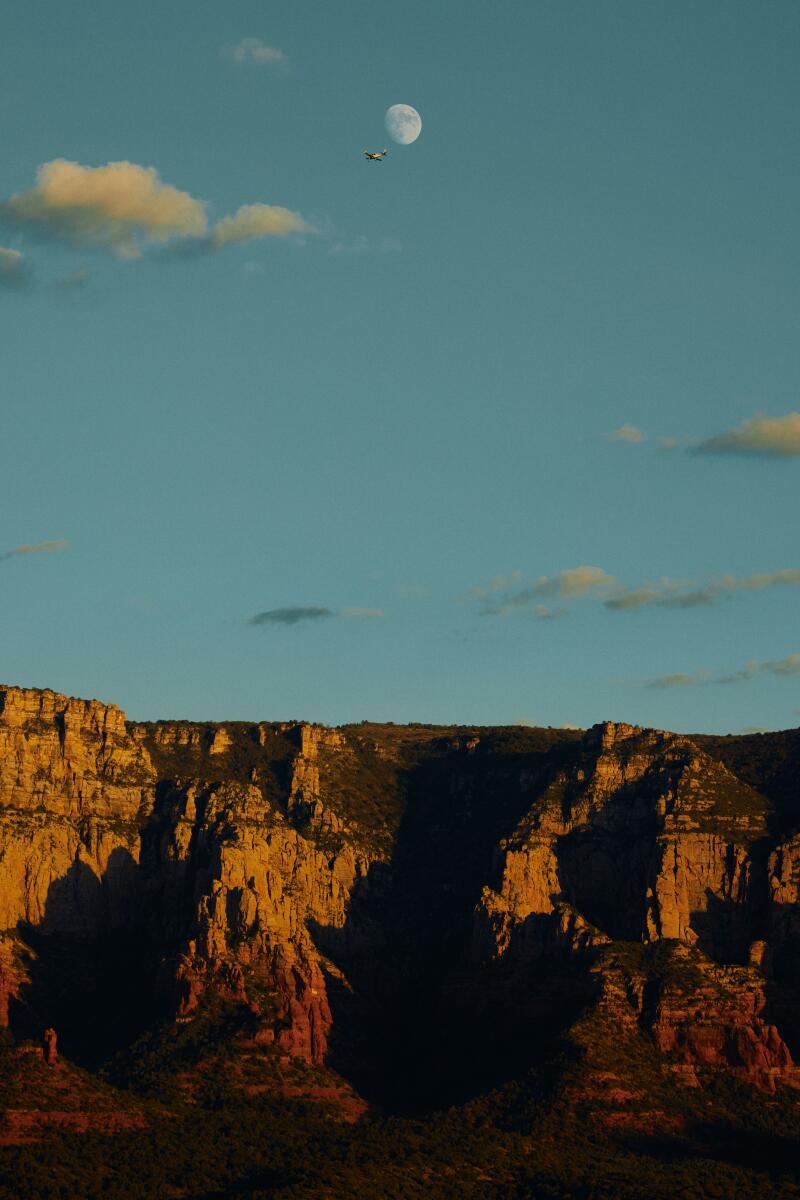
The views from Airport Loop Trail. (Adam Riding / For The Times)

A visitor watches the sun set at Airport Loop Trail. (Adam Riding / For The Times)
“It is beautiful,” she said, the sarcasm draining from her voice. “I’m soaking up the beauty.”
There are people who will tell you that the energy of Sedona’s vortexes is measurable, that it is amplified by a bed of quartz that rests beneath the ground, that it can affect your brain waves and lower your blood pressure, that it is connected to the intersection of ley lines, which are lines of energy that some believe crisscross the Earth. But an open-minded skeptic might find a different take on the vortex easier to swallow.
“The word ‘vortex’ is a simplified one-word label for a place that makes it easier to do prayer, mind-body healing, meditation, tapping higher consciousness, or oneness with the infinite,” said Pete A. Sanders Jr., a founding board member of the Sedona Metaphysical Spiritual Assn. and author of “Scientific Vortex Information.”
“But it’s easier to say, ‘Go to the vortex,’” he said.
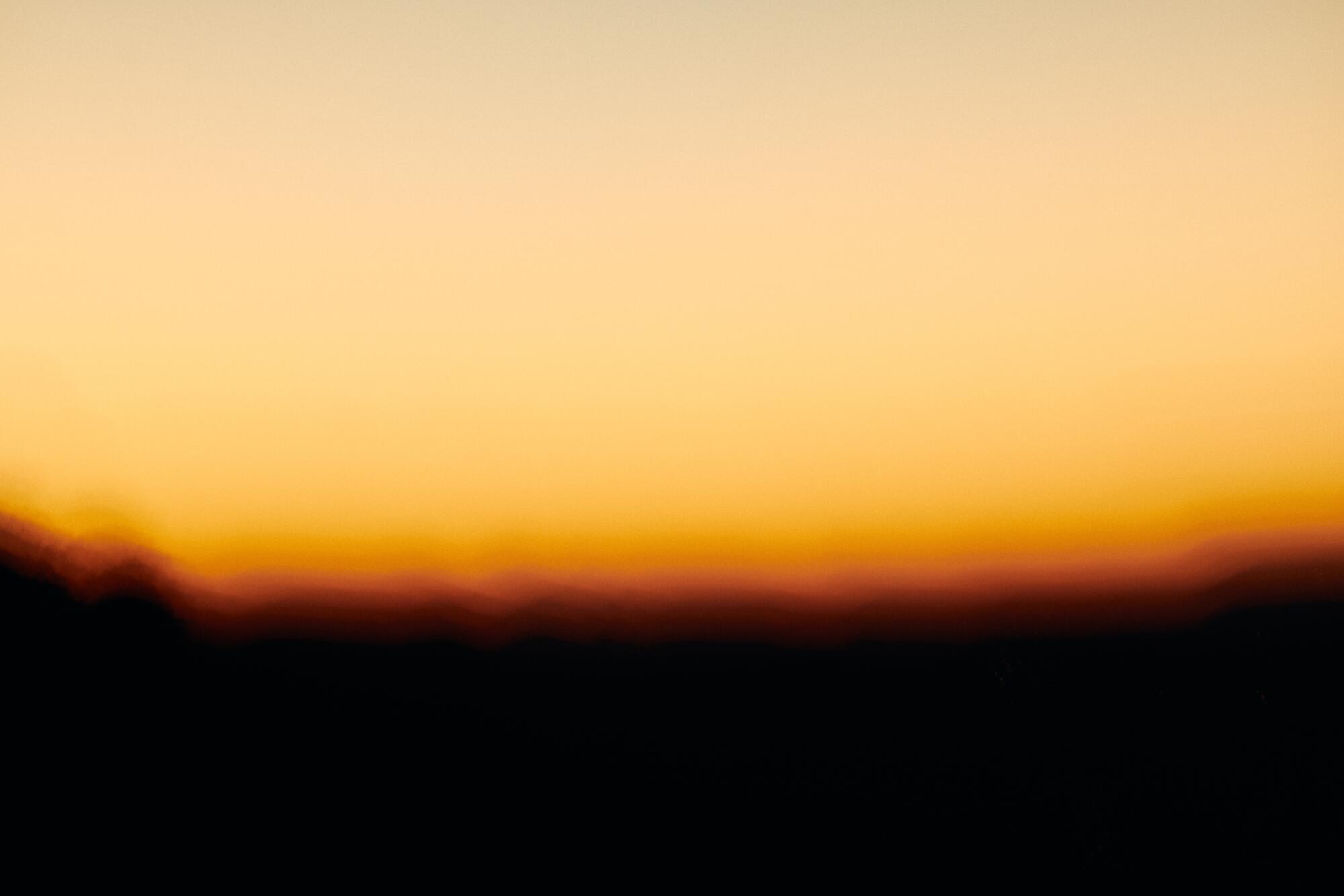
The Hollywood Hills are a vortex too?
Sanders, who has a trim white beard and a math teacher vibe (he keeps his phone in a case clipped to his belt), has been teaching people to work with vortex energy — what he calls “the vortex effect” — since 1980. But in recent years his perspective on these sites has evolved. He still believes that the conditions in Sedona are among the best in the world for creating the energy that supercharges prayer, meditation and mind-body healing — he attributes it to the inspiring greens and reds of the landscape — but he argues that Sedona does not have a monopoly on the phenomenon.
At the weekly vortex talks he gives at hotels around town, he teaches visitors not only how to tap into the energy of Sedona’s vortex sites but also how they can seek that energy closer to their own homes. “Being inspired by a hillside you see or a nature picture can do it,” he said. “Pyramidal topography is an upflow vortex. The visual pulls you up.”
The Hollywood Hills are a vortex, said Sanders, who grew up in the San Fernando Valley. So is Griffith Observatory. So are the San Gabriel Mountains and the Santa Monica Mountains.
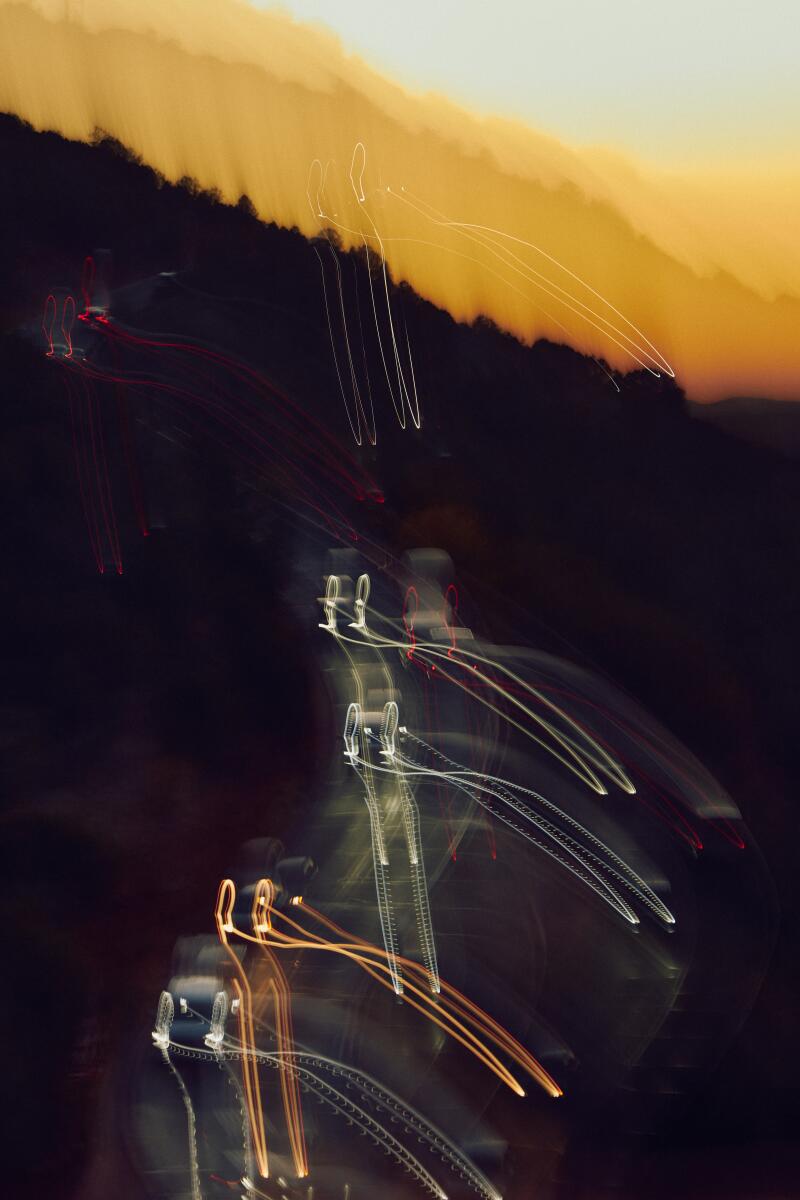
Car lights bounce in this long-exposure photograph taken at Airport Loop Trail. (Adam Riding / For The Times)
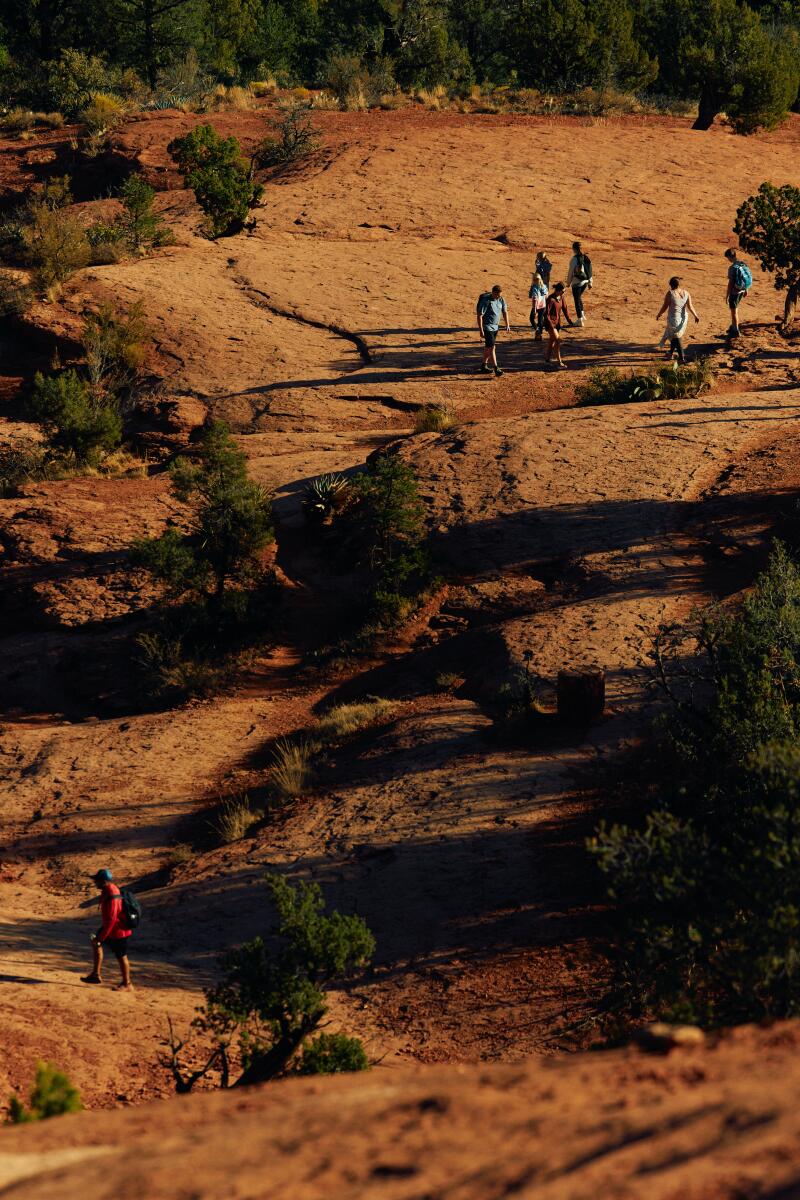
Hikers take in Cathedral Rock, which is among the most popular vortex sites. It’s known to glow when the sun hits it. (Adam Riding / For The Times)
“We love having people’s tourist money here,” he said. “But if people never come to Sedona, they can still have a vortex experience.”
While this perspective is not universally accepted among Sedona’s vortex tour guides, many agree that a focus on just a handful of sites misses the point.
Banah Winn, a musician, sound healer and vortex guide who moved to Sedona from Los Angeles in May, said there are 60 different vortex sites in Boynton Canyon alone. He’s been to 10. And while he doesn’t think there are any Sedona-level vortexes in L.A., he said the Self-Realization Fellowship’s Lake Shrine in the Pacific Palisades comes close.
Andres said that after 18 years of leading vortex tours in the area, he has concluded that seeking out a handful of specific and overly crowded locations will only lead visitors to disappointment.
They are not going to levitate when they get there.
— Dennis Andres, Sedona spiritual guide
“They are not going to levitate when they get there,” he said.
To get the most out of Sedona, visitors should expect to take an active role in the spiritual experience they hope to have rather than just sitting at the base of a red rock and waiting for a miracle, he said. Show up with an open mind; show up with an intention. Do a meditation. Join a retreat.
“What’s more interesting to me, and what’s happening now, is helping people connect with this energy,” said Andres. “Instead of being passive, how can they be intentional?”

Tune in, relax and surrender
Kim Sieb, a former national park ranger turned vortex tour guide and spiritual healer, became the owner of Sedona Mystical Tours in 2020 after the former owner approached her at a trailside parking lot. He had been told by an astrologer and psychic that she would be his successor.
On a recent Wednesday she met three people who had signed up for a two-hour vortex tour ($200 for the first person, $75 for each additional person) at the trailhead of Courthouse Vista. It was 8 a.m. and the parking lot was already full.
Dressed in tan pants and tan lace-up moccasins with a pale blue shawl wrapped around her shoulders, she walked for a quarter of a mile before stepping off the path. Standing beneath a twisted juniper tree, she spritzed the attendees, including me, with a fragrance she made herself from native plants. She encouraged us to breathe deeply and imagine ourselves rooting into the ground. Then she held a tuning fork over our heads.

Visitors doing yoga at Bell Rock. Spiritual guides suggest shaping your own experiences at vortexes. (Adam Riding / For The Times)

The moon transforms into a squiggly line in this long-exposure photo taken at Airport Loop Trail. (Adam Riding / For The Times)
The day was beautiful, crisp and bright, but I found it hard to focus. Whether that’s because of the energy coming from nearby Bell Rock (an electric vortex), the steady stream of other hikers walking by or the sudden and uncontrollable coughing fit that seized me just then, I leave it to you to decide.
I felt much better after we made our way to another clearing near Courthouse Rock, which is said to be a magnetic vortex. After warning us to be careful not to step on the biodynamic crust that is essential to Sedona’s ecosystem, Sieb spread out blankets on a sandy wash and invited us to lie down for a sound healing.
Founded in 1934 by author and lecturer Manly P. Hall, L.A.’s Philosophical Research Society has evolved into a modern cultural events and art space with an esoteric edge.
The sun was warm but not yet hot, and the ground was more yielding than I expected. Sieb began by hitting a wide flat drum above us that I felt reverberating in my chest. Then she began to gently strike the Tibetan bowls she’d placed around our heads and on our bellies.
As she led us in a meditation, I felt myself relax further and further, maybe more than I ever had. She told us to imagine that the Earth was rising up to meet our bodies just as our bodies were reaching down toward the Earth. That there was iron in the red rock all around us just as there is iron in our blood. That water was moving in pathways beneath the ground where we were lying, just as it moves in pathways through us.
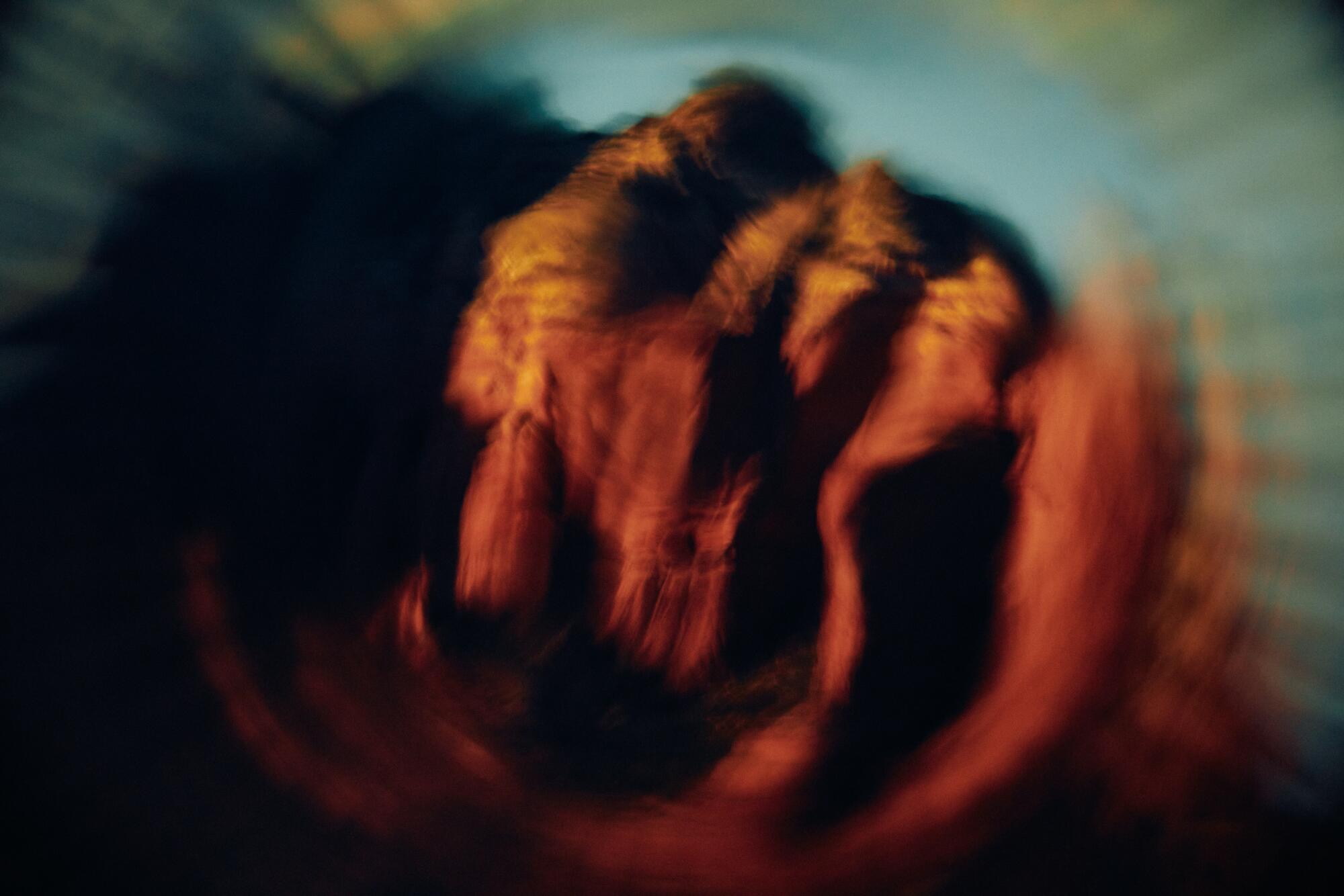
I felt a terrific sense of surrender and merging into the Earth, and a very strong impulse not to move from this spot ever again. Later, I would describe it as “sticky.”
I felt this same stickiness that evening, watching the sunset at Airport Mesa, and again when I tucked myself into a crevice at the bottom of Kachina Woman after the other meditators had left. I felt it again when I woke up early on my last day in Sedona and watched the sun light up Cathedral Rock.
Some might say it was the scenery. Some might say I was just tired. Some might say it was the vortexes.
I say, who knows?
Some images in this story were made through unconventional means — using long-exposure techniques or by photographing (or rephotographing existing images) through warped glass objects — with the goal of mirroring the feelings some people expect to have at vortex sites.
- Share via
Watch L.A. Times Today at 7 p.m. on Spectrum News 1 on Channel 1 or live stream on the Spectrum News App. Palos Verdes Peninsula and Orange County viewers can watch on Cox Systems on channel 99.
More to Read
Sign up for This Evening's Big Stories
Catch up on the day with the 7 biggest L.A. Times stories in your inbox every weekday evening.
You may occasionally receive promotional content from the Los Angeles Times.

